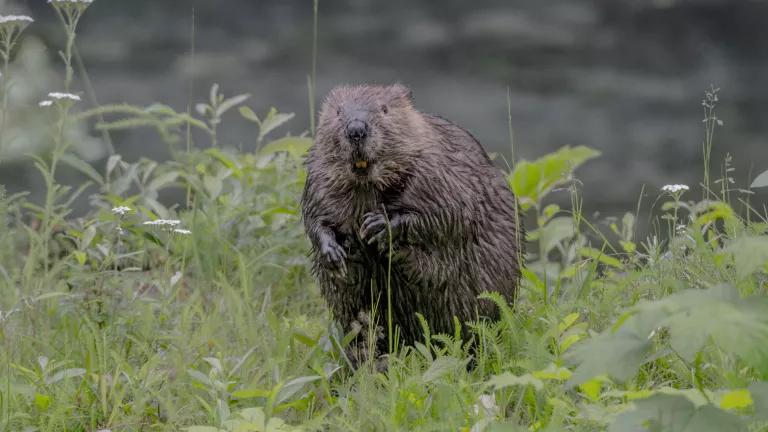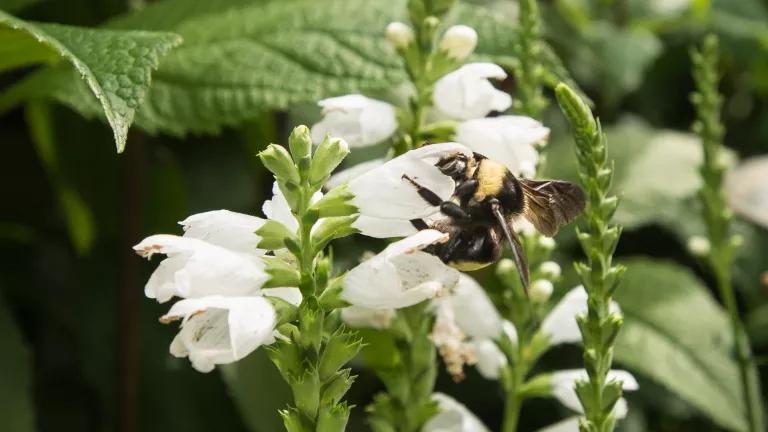Partnering with Beavers to Adapt to Climate Change
Beavers and their habitat increase ecosystem health and help people and wildlife adapt to a warmer planet.

Erwin Weston/USFS
Mitigating climate change and adapting to a warming planet requires as many partners as we can muster. This includes embracing nature as a key ally. Estimates suggest that nature-based solutions can provide 37% of the mitigation needed to keep climate warming below two degrees Centigrade. And, nature, can help us prepare for the changes we are already experiencing and know are coming. Many people appreciate that if we plant more trees, they can both cool our cities and absorb carbon. But, perhaps less well known are the many benefits that beavers bring to the climate fight. Beavers are ecological engineers whose ponds store carbon, improve water quality, create habitat to support biodiversity, and help reduce climate impacts.
Beavers increase our ability to adapt to floods, droughts, and wildfires
Riverscapes are stream or river habitats and their associated floodplains, wetlands, and riparian vegetation. These habitats are disproportionately important parts of the landscape, especially in arid and semi-arid regions. Riverscapes with beaver dam complexes are capable of naturally storing more water during storms and slowly releasing it later in the year. This reduces flood peaks and can prolong water availability during periods of heat and drought, supporting riparian vegetation and decreasing water-related stresses for aquatic and terrestrial wildlife. The wet, saturated soils and braided stream channels don’t readily burn and can therefore also serve as firebreaks, slowing the spread of fire, and giving firefighting teams time to contain them before they get out of control.
A beaver complex in California stayed green and healthy even as the Dixie and Sugar fires burned the surrounding landscape in 2021. | Dr. Emily Fairfax
Beavers improve water quality and create biodiversity hotspots
Beaver-dam complexes improve water quality and reduce pollution. One way this is achieved is by providing a vegetated buffer between agricultural lands, transportation corridors, and other land uses and adjacent water bodies, which can filter out pollution and sediment before they can impact water quality. Maintaining or increasing beavers and their habitat benefits a wide array of native aquatic and terrestrial species. Beaver habitat provides microclimates and shade, complex hydraulics, clean and abundant water, nutrient cycling, and food-web support for a wide range of aquatic and terrestrial organisms, including endangered species. These benefits increase in importance as the climate warms.

Up and down the West Coast, beavers and their habitat are being enlisted to help Pacific salmon and steelhead populations recover.
Bureau of Land Management Oregon and Washington/ Flickr
Where did all the beavers go and how do we get them back?
Prior to European exploration and settlement, valleys across North America were veined with channels and wetlands that recharged aquifers, slowed wildfires, and sustained fish and wildlife. Wetlands constituted roughly 9% of the land surface of the continental United States. Over time, the beaver population—which is estimated to have been 100-200 million across the continent—dwindled to approximately 100,000 by 1900 as a result of historic beaver trapping, poorly managed grazing and logging, and other forces that severed streams from their floodplains and dried up streamside forests and wetlands. As beavers were removed, multi-threaded streams and rivers were typically replaced by a single channel which concentrated water flows, eroded streambanks, and stripped away many of the benefits described above.
Today, the beaver population in North America is estimated to be 10-15 million animals. And, wetlands in the continental United States have been reduced by more than half. Where beavers are absent or reduced in number, we are left without the rodent partners that can repair and restore our degraded streams and wetlands and sustain the ecosystem services communities need. Luckily, we can help nature bring back the conditions that beavers need by kickstarting natural processes. If we take steps to make riverscapes healthier again, beavers can return and get to work making dams of their own. Once this happens, ecosystem services can start to accrue.
This short animation illustrates how we lost streams and their wetlands over time and the steps we can take to restore beavers and their benefits. Credit: NRDC/Lily Padula
Three things we can do to restore beavers and their benefits
Deploy national assets—including public lands and federal funding—to preserve and restore beavers and their habitat.
The White House recently released a report outlining how we can invest in nature to solve today’s challenges. The report called out protecting beavers as a nature-based solution and recommends using federal facilities and assets to deploy a suite of nature-based approaches. To accomplish this, the Department of Interior and U.S. Department of Agriculture should work together to launch a National Healthy Riverscape Initiative to prioritize and invest in maintaining and restoring freshwater habitat on public lands. To support such an effort, the Bureau of Land Management should finalize its Public Lands Rule with strong provisions for both conserving and restoring priority lands and waterways. At the same time, the Federal Emergency Management Agency (FEMA) should increase investments in wetland protection and restoration to support communities and tribes seeking to invest in nature-based solutions to reduce future flooding or increase ecological resilience to drought. By protecting and recovering the places that beavers live, programs such as these can give these critical animals an opportunity to revitalize the entire landscape.
Design state-based programs to build a more nature positive future for communities, ecosystem services, and beavers.
In 2022, the California legislature provided essential funding to the California Department of Fish and Wildlife to invest in beavers’ natural ability to improve ecosystem health and help adapt to climate change. The agency is currently staffing up and developing a comprehensive beaver management program. Across the country, states are working to update their State Wildlife Action Plans (SWAPs) which will guide fish and wildlife conservation starting in 2025. Congress requires a SWAP for all states and territories that apply to the State and Tribal Wildlife Grants program which has distributed over one billion dollars since 2000. While beavers aren’t threatened, their beaver ponds create essential habitat for many species of greatest conservation need. Protecting and restoring beaver habitat should be prioritized in SWAPs. Finally, state, tribal, and local governments, can prioritize wetland protection and restoration to help reconnect streams to their floodplains as a risk mitigation strategy in the hazard mitigation plans required to secure grants from FEMA.
Learn from and invest in tribal wildlife programs that are leading the way in restoring beavers on their ancestral lands.
Tribes across the West are demonstrating what is possible when beavers are returned to the landscape. The Tulalip Beaver Project relocates "nuisance" beavers to hydrologically impaired tributaries in Washington’s upper Snohomish Watershed to improve fish rearing habitat and retain more freshwater in the watershed for longer periods of time. In Montana, the Blackfeet Nation’s Ksik Stakii Beaver Mimicry Guidebook focuses on mimicking beaver habitat to restore streams and naturally store water. And, in California, Indigenous leaders are leading the way in advocating for policies that support beavers to benefit salmon conservation and contribute to holistic land restoration.
If given the chance, beavers can serve as a free restoration workforce that increases our ability to adapt to climate change while also stemming biodiversity loss. Positive stories of communities, tribes, and landowners partnering with beavers are emerging across the country—let’s create more of them.




